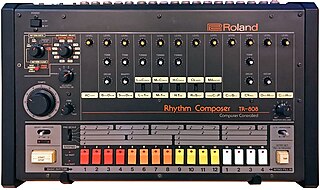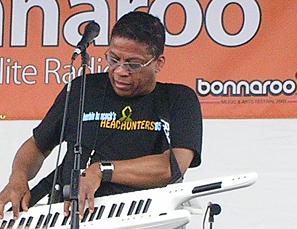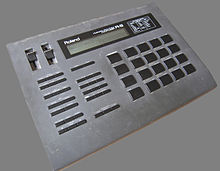Roland Octapad is a range of MIDI electronic drum percussion controllers produced by the Roland Corporation.

The Roland TR-808 Rhythm Composer, commonly known as the 808, is a drum machine manufactured by Roland Corporation between 1980 and 1983. It was one of the first drum machines to allow users to program rhythms instead of using preset patterns. Unlike its nearest competitor at the time, the more expensive Linn LM-1, the 808 generates sounds using analog synthesis rather than by playing samples.
Akai is a Hong Kong-based manufacturer of consumer electronics. It was established as Akai Electric Company Ltd in Tokyo, Japan, in 1946.
Steinberg Media Technologies GmbH is a German musical software and hardware company based in Hamburg. It develops software for writing, recording, arranging and editing music, most notably Cubase, Nuendo, and Dorico. It also designs audio and MIDI hardware interfaces, controllers, and iOS/Android music apps including Cubasis. Steinberg created several industry standard music technologies including the Virtual Studio Technology (VST) format for plug-ins and the ASIO protocol. Steinberg has been a wholly owned subsidiary of Yamaha since 2005.
Emagic was a music software and hardware company based in Rellingen, Germany and a satellite office in Grass Valley, California. On July 1, 2002 Emagic was bought by Apple Computer. Emagic's Windows-based product offerings were discontinued on September 30, 2002.

The Roland MT-32 Multi-Timbre Sound Module is a MIDI synthesizer module first released in 1987 by Roland Corporation. It was originally marketed to amateur musicians as a budget external synthesizer with an original list price of $695. However, it became more famous along with its compatible modules as an early de facto standard in computer music. Since it was made prior to the release of the General MIDI standard, it uses its own proprietary format for MIDI file playback.
The Yamaha TX81Z is a rack-mounted (keyboard-less) frequency modulation (FM) music synthesizer, released in 1987. It is also known as a keyboard-less Yamaha DX11. Unlike previous FM synthesizers of the era, the TX81Z was the first to offer a range of oscillator waveforms other than just sine waves, conferring the new timbres of some of its patches when compared to older, sine-only FM synths. The TX81Z has developed a famous reputation, largely based on some of its preset bass sounds. The Yamaha DX11 keyboard synth was released the following year, offering improved editing abilities.

The Roland Corporation has manufactured several keytars.

The Roland TR-505 rhythm composer is a drum machine and MIDI sequencer released by Roland Corporation in 1986. It hails from the same family of drum machines as the Roland TR-909, TR-808, TR-707, TR-626 and TR-606. The drum kit includes basic rock drum sounds similar to those of the TR-707, plus a complement of Latin-style drum sounds similar to the TR-727.

The Korg X3 is a music workstation produced by Korg in 1993.

The Roland JD-800 is a digital synthesizer that was manufactured between 1991 and 1996. It features many knobs and sliders for patch editing and performance control — features that some manufacturers, including Roland, had been omitting in the name of streamlining since the inception of the Yamaha DX7. The JD-800 thus became very popular with musicians who wished to take a hands-on approach to patch programming. The introduction in the manual states that Roland's intention with the JD-800 was to "return to the roots of synthesis".

The Kurzweil K2000 is a digital synthesizer and music workstation produced by Kurzweil Music Systems between 1991 and 2000 in a variety of standard configurations, including rack-mountable versions and models that came with 16-bit user sampling.
The Yamaha SY85 is a digital music workstation introduced in 1992. Unlike other Yamaha synthesizers of the time the SY85 does not use FM synthesis. Instead, its sounds are based on samples, which can be layered and modified to create new sounds.

Yamaha SY77 is a 16 voice multitimbral music workstation first produced by Yamaha Corporation in 1989. The SY77 is a synthesizer whose architecture combines AFM synthesis, AWM2 for ROM-borne sample-based synthesis, and the combination of these two methods christened Realtime Convolution and Modulation Synthesis (RCM). The same technology was also packaged in a rack-mounted module released simultaneously, the TG77.
The Roland JD-990 Super JD is an updated version of the Roland JD-800 synthesizer in the form of a module with expanded capabilities, which was released in 1993 by Roland Corporation. JD-990 is a multitimbral synthesizer utilising PCM sample-based synthesis technology. In a sense it is not a true module version of a JD-800 as it has many expanded features and as a result the two are incompatible in exchanging presets. It is equipped with 6 MB of ROM containing sampled PCM waveforms, four sets of stereo outputs that are assignable to individual, internal, instruments, and standard MIDI in/out/through ports. JD-990 has a large LCD display and programming takes place through a keypad on the front panel of the unit. The unit can generate multi-timbral sounds reminiscent of the vintage analogue synthesizers but is also capable of generation of modern digital textures. There are several expansion boards available for JD-990 that can be installed in the provided expansion slot in the chassis of the unit.
The Akai S1000 is a 16-bit, 44.1 kHz professional stereo digital sampler, released by Akai in 1988. The S1000 was among the first professional-quality 16-bit stereo samplers. Its abilities to splice, crossfade, trim, and loop sound in 16-bit CD quality made it popular among producers in the late 80s through to the mid 90s. The S1000 used 24-bit internal processing, had digital filters and an effects send and return, and came with 2MB of RAM.
Gajits Music Software, also known as Software Technology Ltd., was a software company based in Manchester, England. The company developed music software for the Atari ST and Amiga in the early 1990s.
The Roland DDR-30 "Alpha Drum" is a digital PCM drum module built by Roland, in early 1985. It was introduced during 1985 Summer NAMM industry trade show in New Orleans.
The Yamaha PTX8 is a digital sample-based percussion tone generator built by Yamaha, in late 1986. It was included in the Yamaha D8 electronic drum kit.







